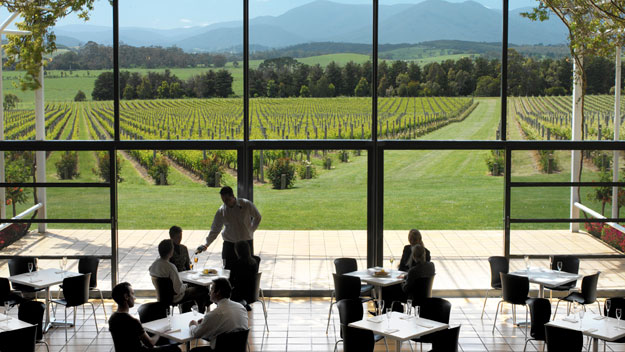France rediscovered
As you journey through south-west France, a landscape of turreted chateaux, arched bridges and rose-tinted roof tiles unfolds among the vineyards. It’s a rural idyll dominated by the past, where Gothic cathedrals rise above sleepy market towns and medieval castles tower over fortified villages. The French call it Aquitaine – land of legends.
Julius Caesar had another name for it – “land of water”, because of its network of meandering rivers, including the Dordogne, today a byword for scenic beauty. While the Roman emperor paid the area an occasional visit, its most famous resident, Richard the Lionheart, son of Eleanor of Aquitaine, called it home. King of England, Richard spent more time in Aquitaine than he did in the country he ruled, dying there, in his mother’s arms, after a siege in 1199.
Visitors often wonder how Aquitaine’s medieval past still stands in such good fettle 700 years later. The French proverb, “An empty purse is the great preserver of history”, gives a clue. As Aquitaine’s capital, Bordeaux, became rich on wine revenue, its rural hinterland languished. And ever since, life on the land has continued at an unhurried pace. Grapevines are pruned and harvested, and hand-grown produce continues to be sold at market.
Pate de foie gras, tiny sweet strawberries, melons, chestnuts and sweet cider can be found. Keep an eye open, too, for white asparagus, pink garlic, goat’s cheese and walnuts. Not to mention the famed Bazas beef, known for its fine grain, tenderness and superb flavour, which the French savour with the inky red wine of Cahors, once popular with the Czars of Russia. And then there is armagnac, cognac’s southern cousin, considered one of the world’s finest spirits.
Aquitaine stretches from the great Atlantic port of Bordeaux in the west to the sunny city of Toulouse in the south-east. Its northern borders flank the oak forests and limestone gorges of Perigord. Between lies the Dordogne, and the medieval city of Sarlat-la-Canéda, once described by the American author Henry Miller as “the closest thing to heaven on earth”. Further south is the Gers region, with its Gallo-Roman town of Condom and many fortified hamlets, known as bastides.
If the Dordogne is known for its perched castles and chateaux, many of which cling to precipitous limestone cliffs, Lot-et-Garonne is renowned for its perched villages. A gentler, more fascinating part of France you’ll be hard-pressed to find.
Bordeaux
Located on the estuary of the Garonne River, a short drive from the sweeping beaches of the Atlantic, Bordeaux is one of Europe’s new weekend destinations. A two-year facelift has removed the grime, revealing magnificent 18th-century facades. A futuristic tramway now snakes around the city, and the quaysides offer impressive waterfront views. At night, its pale golden buildings and cobbled streets are skillfully floodlit.
Stay: La Maison Bordeaux boutique hotel, tucked in a courtyard (113 Rue Albert Barraud; www.lamaisonbordeaux.com). Rooms from $220.
Visit: In the heart of the city, Quartier St Pierre has many cafes and clubs. Stand on the Pont de Pierre for a panoramic view of Bordeaux’s splendid waterfront. Visit the Sunday seafood market at the Quai des Chartrons.
Be seen: Dame de Shanghai restaurant/bar on the Quai Armand Lanlande is a converted wooden boat lit with red lanterns (www.damedeshanghai.com).
Eat: L’Estaquade, a wood and glass cabin perched on stilts in the Quartier Bastide on the other side of the Garonne, offers views of the city across the river. A three-course lunch costs from $30 (www.lestacade.com). Musée d’Art Contemporain, an old converted spice house on Rue Ferrere and the perfect place for a Sunday brunch (from $25) in the rooftop Café du Musee (www.bordeaux.fr).
Shop: The Alleés de Tourney (known as Bordeaux’s golden triangle) houses flashy boutiques, funky jewellery and antique shops, chocolatiers and L’Intendant, a stylish wine store housed in a cylindrical tower of ancient stone and modern metal, where women in Chanel suits serve you.
Condom
Known as the “little capital” of Armagnac, Condom has been the butt of many English jokes. However, in French the word has no connection with contraception. It sits on the Baise River and the town’s sandstone quays once witnessed millions of barrels of armagnac being loaded onto barges for the journey to Bordeaux. These days, boats take tourists on lazy half-day trips along the river.
Stay: Hotel des Trois Lys overlooks a courtyard (Rue Gambetta; visit: www.lestroislys.com; phone: 05 62 28 33 33). Rooms from $150.
Eat: Aux Delices du Roy (Rue du Chateau; phone 05 53 65 81 12), a seafood restaurant, in the nearby Nerac, which also serves regional specialities.
Visit: The Gothic cathedral and cloisters, the Armagnac Museum and the Wednesday market.
Places to visit around Condom
Larressingle
Five kilometres west of Condom, this bastide is one of the best preserved in France. Once a shelter for pilgrims on their way to Santiago de Compostela in north-west Spain, it’s surrounded by its original walls, has a church, a keep (castle fortifications) and a small crêperie.
Moncrabeau
Perched on the top of a hill, this village is a must for all politicians. On the first Sunday of August, it holds the Fête des Menteurs (“Fête of Fibbers”). The contestant who tells the tallest story is pronounced “Roi des Menteurs” (“King of the Liars”) and earns the right to be economical with the truth, any time, any place.
Chateau de Cassagne
Twenty minutes south-west, this 13th-century chateau is in the heart of Armagnac. Here, you can visit the cellars, sample and buy armagnac, or take a walk around the grounds and into the village. Do try the exquisite raspberry liqueur armamboise.
Vianne
This glorious bastide, with its tower gates and sturdy walls, is an hour north, via Nerac. On the Baise River, it is the perfect place to have lunch, before visiting the great castle of Barbaste nearby.
The road to Toulouse
A scenic route from Condom to Toulouse is on the D roads via Lectoure, Fleurance, Mauvezin and L’Isle Jourdain. It’s a round-about way that allows you to visit the unspoilt villages of La Romieu, St Clar, Marsolan and Castera Lectourois. Stop for lunch at the Gallo-Roman city of Lectoure, that’s perched on a ridge overlooking the Gers River. If you smell a tang in the air, it’s because a third of France’s garlic is grown in this region. If you’re passing by on a Tuesday, stop off at Fleurance for its famous market.
Toulouse
Known as the “pink city” because of its red-brick buildings that change from pale rose in the morning to deep purple at dusk, Toulouse has an exotic Mediterranean feel, thanks to its sunny climes, southern charm and proximity to Spain. As in Bordeaux, the Garonne runs through the centre, where stone bridges arch gracefully over the river. Around the Place du Capitole, you’ll find cobbled streets and the city’s historic heart.
Stay: The Wilson Square Hotel is on a little park close to the centre (Place Wilson, Rue d’Austerlitz; www.hotel-wilson.com). Rooms from $100. Visit: Cité de L’Espace, the Space Park museum (Avenue Jean Gonord on the eastern outskirts) with its life-size model of the Mir space station. Be seen: Exploring the cafe-filled squares of the old quarter around Place Saint Pierre.
Eat: Lunch upstairs in one of the many restaurants in the covered market at Place Victor Hugo. Dinner at the riverside Brasserie Flo (1 Quai de la Daurade; phone 05 61 21 12 12), opposite Pont-Neuf, where you can enjoy a three-course dinner, from $55, in the splendour of Belle Epoque decor.
Shop: Rue de Rome with its trendy fashion shops and designer boutiques, second-hand jewellery and kitsch speciality shops. Look out for clothes and accessories in blue/indigo, created from woad, a local dye. Also, the covered market at Place Victor Hugo (open every morning except Mondays) with its mouth-watering produce.
Sarlat-la-caneda
Sarlat is the best place to stay and explore the pretty villages of the southern Dordogne and western Lot. It has a fascinating labyrinth of cobbled streets, steps, squares, arcades and beautifully preserved medieval buildings. On the way north from Toulouse, stop off for lunch at Cahors, famous for its old quarter and spectacular medieval bridge, Pont Valentré, with its three towers and six Gothic arches. The city’s inky red wines – the darkest in France – were once popular with the Czars of Russia. Cahors also has a great fresh produce market each Sunday.
Stay: The historic two-star La Couleuvrine on the main square at 1 Place de la Bouquerie (www.logis-de-france.fr; phone 05 53 59 27 80). Rooms from $75.
Eat: Restaurant Rossingnol on 15 Rue Fenelon (phone 05 53 31 02 30) for lunch at $35 a head.
Places to visit around Sarlat
Lascaux Caves
At the village of Montignac, you’ll find the “Sistene Chapel of Prehistoric Art”, where there are 17,000-year-old Cro-Magnon rock paintings of mammoths, horses and bison.
Domme
Like so many other little towns on the Dordogne River, it clings to cliffs on top of a gorge overlooking the valley. Larger than most, it has beautiful buildings and views
that attract tourists in their thousands, so get there early.
Rocamadour
Perched on the edge of a gorge 500 metres above the river, this village looks like a classic fairytale castle. Back in the Middle Ages, Rocamadour’s holy relic, the corpse of St Amadour, could pull a crowd of 30,000, until the Protestants sacked the place and chopped it into bits. Pretty to look at, sadly, this village has lost its soul. Full of souvenir shops, it’s best to visit early in the morning before they open and the tourists arrive.
La Roque Gageac & Beynac
Both five minutes from Domme, La Roque and its neo-Gothic Chateau de la Malatrie sit next to the limpid Dordogne with market garden cottages rambling up the steep hill, while the fortress of Beynac is perched like an eagle on a cliff top.


